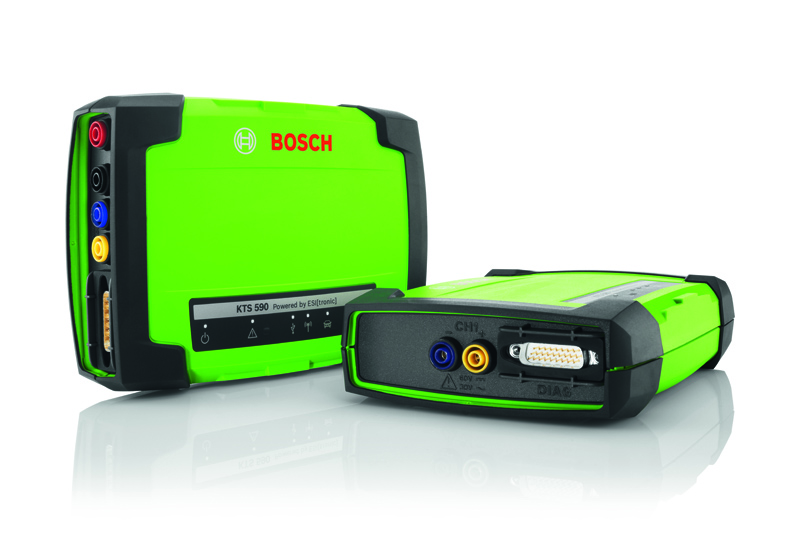
Bosch outlines some simple ways to get the best value from your diagnostic equipment.
We all know new features in vehicles are making repairs more complicated, from parking cameras and keyless entry, to broader changes designed to respond to tighter emissions regulations and greater connectivity, all requiring greater levels of expertise. Some vehicles now have more than 100 different Engine Control Units (ECUs) to look after different systems in the car, posing a problem for technicians trying to find and fix faults. Diagnostic equipment can save valuable time, pinpointing faults rather than technicians wasting time diagnosing by substitution. A diagnostic device can also provide proof to the customer that the problem, which brought the vehicle into the workshop, is now solved.
Diagnostic health check
For those who have invested in equipment, it may seem like obvious advice to get the most from it, but some technicians are still not fully aware of the commercial benefits presented by diagnostic equipment. The System Overview, provided by ESI[tronic] 2.0, provides a list of all ECU systems that are communicating in the vehicle, acting as a complete vehicle diagnostic check. This report can be downloaded and given to a customer, demonstrating either what the fault was, or the health of the vehicle once it has been fixed. A diagnostic check may also flag other service requirements which can be dealt with before they become a problem for the vehicle owner, saving time in the long run.
Independent garages and technicians
The new generation of KTS gives workshops access to OEM solutions without the need to be a franchised dealer. PassThru enables a KTS unit to install and update a car’s internal software – typically the realm of a dealer. A garage no longer needs to purchase several OEM PassThru hardware solutions to cover the range of cars that they are likely to work on, putting valuable OEM data into the hands of independent garages and workshops.
“A diagnostic check may also flag other service requirements which can be dealt with before they become a problem for the vehicle owner, saving time in the long run.”
The right information at your fingertips
ESI[tronic] software ensures that information and processes are available and tailored to a specific vehicle type. The system then provides detailed information on vehicles, including menu tabs for ‘Vehicle Info’, ‘Diagnosis’, ‘Troubleshooting’, ‘Maintenance’, ‘Circuit Diagrams’ (depending on the subscription level) and ‘Equipment’ (parts). These guide the user through all the relevant functions and data that Bosch has for that vehicle, allowing a smooth, personalised diagnostic process. Service related and technical information guides you through the diagnostic procedure. However, if the wrong vehicle is selected by mistake and the diagnostic ECU system is not fully identified, then some diagnostic functions may not work properly.
Knowing the vehicle type, drive type, make, model series and engine code can help identify the correct RB code – a unique ‘Robert Bosch’ reference stored within the system to identify vehicles. However, if the device is already plugged into the vehicle, it can identify the VIN details and therefore the vehicle type. The VIN on some vehicles doesn’t contain model-specific information, so the system may require further vehicle specific information to find the RB key and the vehicle-specific guidance.
Keeping KTS up-to-date
One of the best ways to get the most from diagnostic equipment is to keep it up-to-date. Bosch provides routine software updates which need to be uploaded onto the system by a technician or operator. Online updates for ESI[tronic] 2.0 provide new priority systems coverage and enhancements. As well as the online updates, DVDs are sent out by the company, providing further updates to the system. These also need to be loaded onto the system and provide a different type of update to the online options.
On hand to help you out
With new vehicle technology enhancements and vehicles being fitted with advanced electronic systems, Bosch strives to continually improve the KTS tool and the diagnostic functions and technical information within the ESI[tronic] 2.0 software platform.
The Bosch Automotive team employs more than 350 ESI[tronic] software development engineers around the world, working on new diagnostic systems coverage and enhancements for the 180 vehicle brands that are covered by ESI[tronic] 2.0.
The UK-based technical support helpline for technicians using Bosch equipment has two dedicated teams that provide help with hardware or software installation queries and technical vehicle problems that technicians may face. In many cases, a quick call to the technical hotline can give the required solution, but if this doesn’t resolve the issue, then raising it on the manufacturer’s online portal may be the best route to receive the right answers. The portal is a direct link to Bosch’s ESI[tronic] service team who look into the suggestions and requests, and investigate any outstanding errors or faults found with the tool. An ESI ticket must be raised whilst connected to the vehicle, which can then be submitted using the ESI[tronic] system.
The next step
Those purchasing a KTS are offered a free training course within the first three months of purchase, covering the operation of the KTS and ESI[tronic]. Putting the serial number of the product onto the booking form entitles the user to the free session, and will include the basics of operation, as well as how to get the best out of the equipment.
For those looking for a more in depth knowledge of diagnostics, the Bosch Diagnostics Technician Programme is designed to give a thorough and comprehensive grounding in diagnosing faults across a range of systems. Hosted either at the Bosch Service Training Centre or regional venues based around the country, a series of sessions is available for technicians to learn about the latest systems and technologies.









